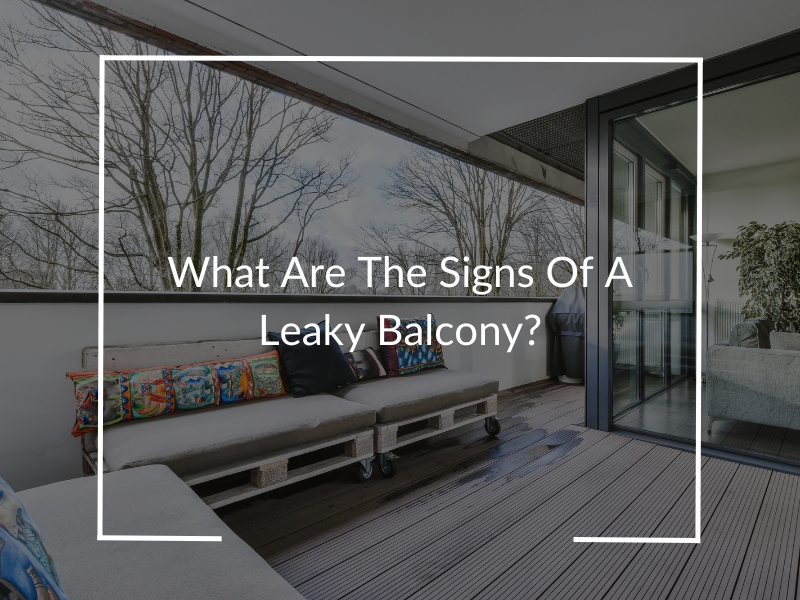Balconies can be beautiful additions to any home, providing a space to relax and enjoy the outdoors. However, balconies can develop leaks over time, leading to costly damage if not promptly addressed. But how can you tell if your balcony is leaking? This guide explores the key signs to watch for and the potential consequences of leaving a leaky balcony untreated.
What causes a balcony to leak?
Balcony leaks can be caused by a range of factors, all of which compromise the structural integrity of the area. Poor construction, inadequate waterproofing, or aging materials can all contribute to water infiltration. The main culprits include:
- Faulty waterproofing: If the membrane beneath your balcony isn’t installed correctly or has deteriorated, water can seep through cracks and cause leaks.
- Poor drainage: Water must flow efficiently away from the balcony surface. Insufficient drainage can cause water pooling, leading to long-term moisture damage.
- Structural movement: Over time, buildings settle, causing balconies to shift slightly. These small shifts can crack waterproofing membranes, letting water in.
- Wear and tear: Exposure to weather conditions such as rain, sun, and wind can degrade balcony materials, making leaks more likely.
What are the visual signs of a leaky balcony?
Spotting the early signs of a leaking balcony can save you from costly repairs. Here are the most common visual indicators:
- Cracked tiles: If you notice cracks or movement in your balcony tiles, this can be a sign that water is getting through to the waterproof membrane below.
- Efflorescence: A chalky white residue on your tiles or grout is a sign of water moving through the surface and leaving mineral deposits behind.
- Deteriorating grout: Worn or missing grout between tiles may allow water to seep into the structure, indicating a potential leak.
- Wet patches: Persistent damp patches on the balcony surface, even in dry weather, are clear signs that water is trapped within the structure.
- Mould and mildew: If you notice mould or mildew growth on the balcony, it strongly indicates that moisture is present and not being adequately drained away.

Can a leaky balcony affect the interior of your home?
A leaking balcony doesn’t just impact the outdoor space – it can also lead to issues inside your home. Water can infiltrate the internal structure and cause significant damage. Here’s how a leaky balcony might affect your home:
- Ceiling stains: If your balcony is above an indoor room, you may notice stains or discolouration on the ceiling below. This is a telltale sign that water is seeping through.
- Wall dampness: Moisture from a leaky balcony can travel into the walls beneath, leading to damp patches or bubbling paint on interior walls.
- Flooring damage: Water leakage can damage floors inside the home, particularly in rooms directly under the balcony. Wooden floors may warp, while carpets can become soggy and prone to mould.
Is there any water pooling on your balcony after rain?
Water pooling is a direct sign that your balcony isn’t draining as it should. Poor drainage systems can cause water to sit on the surface long after rain has stopped, potentially leading to leaks. Here are the warning signs to watch for:
- Persistent puddles: If water lingers on the balcony surface after a downpour, this indicates poor drainage. Left untreated, these puddles can seep into the structure below.
- Blocked drains: Check whether your balcony drains are clear and functioning. Blocked or undersized drains can cause water to back up and pool, increasing the likelihood of a leak.
- Uneven surfaces: An adequately designed balcony should slope slightly to encourage water to flow towards drainage points. If the surface is uneven, water may pool in low spots, accelerating deterioration.
Adhere to best practices for balcony drainage systems outlined in the National Construction Code to ensure optimal balcony performance and longevity.
Are there visible signs of rust or corrosion on balcony fixtures?
Rust or corrosion on balcony fixtures, such as railings and screws, can indicate the presence of moisture, which is a clear sign of water damage. Metal components on your balcony should be inspected regularly for signs of deterioration:
- Rust spots on railings: Rust forming on metal railings or balustrades indicates that water penetrates the surface and compromises the fixtures’ integrity.
- Corroded screws and fasteners: If the screws or fasteners holding your balcony components in place are rusted or corroded, it’s likely due to water ingress.
- Metal flaking or bubbling: When metal starts to flake, bubble, or peel, this suggests that moisture is trapped beneath the surface, causing corrosion.
Why should you be concerned about musty odours coming from your balcony?
Musty odours indicate moisture is present where it shouldn’t be. If you notice an unpleasant smell from your balcony, it’s likely due to mould or mildew growth. Here’s why this should raise a red flag:
- Mould presence: A musty smell is often the first sign of mould. Mould can harm your health, particularly for people with respiratory issues.
- Trapped moisture: Moisture that can’t escape will lead to ongoing damage. If the smell is persistent, it’s likely that water has found its way into the structure and is causing unseen problems.
- Health risks: Prolonged exposure to damp environments can affect indoor air quality and cause health problems.
How does peeling paint indicate a leaky balcony?
Peeling paint is one of the most visible signs of something wrong with your balcony. This seemingly cosmetic issue can indicate more significant problems beneath the surface. Here’s why peeling paint is a sign of a leaky balcony:
- Moisture penetration: When water gets trapped in the balcony’s structure, it pushes against the paint, causing it to peel away from the surface.
- Bubbling paint: If you notice bubbles under the paint, this is a sign that moisture has built up behind the surface, weakening the material and causing it to blister.
- Recurrent peeling: If you’ve repainted your balcony several times and the paint continues to peel, it’s a sign that the underlying problem – water infiltration – has not been addressed.
Protect your home from water damage
If you’ve noticed any signs of a leaky balcony, it’s crucial to act quickly. Sydney Waterproofing Services specialises in diagnosing and repairing balcony leaks, ensuring your home stays safe and damage-free. We provide reliable balcony waterproofing solutions that can prevent future leaks and extend the life of your outdoor space.
Don’t let a slight leak become a big problem – contact Sydney Waterproofing Services today for a thorough inspection and professional repair.



